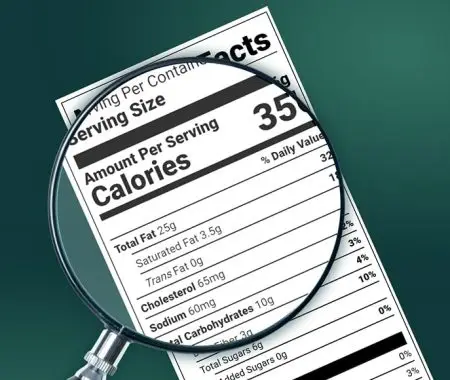The Canadian food scene has seen tremendous transformation in recent years, particularly regarding sweeteners and nutrition labels. Here, taste and transparency collide in sweetener labeling, with a growing emphasis on health-conscious choices and informed consumer decisions.
Health Canada has spearheaded labeling amendments as part of its Healthy Eating Strategy, shaping how sweeteners are presented and understood on food labels nationwide.
Health Canada’s initiatives align with broader efforts to combat rising obesity, diabetes, and other diet-related health concerns. Fostering greater transparency and understanding of sweetener content in food products aims to empower consumers to make choices that contribute to their overall health and well-being.
TLDR
- Sweeteners: Substances used to add a sweet taste to foods or beverages, such as sucralose, aspartame, sugar alcohols, and stevia. They fall under the food additives category and have to be approved by Health Canada for use in Canada.
- Labeling Requirements: Sweeteners must be declared on the ingredients list of pre-packaged foods containing them, alongside their specific names. Some require additional statements such as ‘contains sugar alcohols’ or ‘contains aspartame.’
- Compliance with Maximum Levels of Use: Sweeteners must follow maximum levels of use and other conditions outlined in Health Canada’s List of permitted sweeteners. Exceeding set levels of use may pose health risks or affect the quality and safety of the food.
- Products Requiring Sweetener Labelling: They include snacks, baked goods, confectionery, dairy products, table-top sweeteners, desserts, and beverages with one or more sweeteners.
- Exemptions: Some foods are exempt from sweetener labeling regulations, including foods that aren’t prepackaged, those packaged from bulk at retail, and foods sold only to processors or manufacturers.
- Prohibitions and Nutrient Content Claims: Marketing and nutrient content claims for products containing sweeteners, such as ‘low-calorie,’ ‘sugar-free,’ and ‘reduced in calories,’ are restricted. The claims must meet the criteria prescribed by the Food and Drug Regulations and Safe Food for Canadians Regulations.
- Staying informed about regulatory changes: Stay updated on food regulations by monitoring agency websites, following social media, subscribing to expert content, engaging with regulators, and joining industry associations. Use agile labeling processes with tools like Food Label Maker for clear, compliant labels.
Labeling Requirement for Sweeteners
In Canada, the only sweeteners approved for use are those included in Health Canada’s list of permitted sweeteners and must be used within the conditions of use outlined. Sweeteners must be disclosed in the ingredient list of any pre-packaged meals they are used in, just like any other food additive.
See How FoodLabelMaker Can Help You
High-Intensity Sweeteners: What’s Changed?
The changes affecting high-intensity sweeteners Neotame, Sucralose, Aspartame, and Acesulfame – potassium mean they will no longer need to appear on the front of the package, and their amount in mg per serving will no longer appear in the list of ingredients.
None of the other approved sweeteners need this extra labeling, meaning the changes will standardize the labeling of all sweeteners in Canada. Food sweeteners will still be listed among the ingredients on the product label.
Requirement for Aspartame
Aspartame-sweetened foods must still have a warning label stating that aspartame contains phenylalanine or a statement alerting people with phenylketonuria to the presence of phenylalanine in the meal. This statement must now appear in bold at the end of the list of ingredients.
If aspartame is used with other sweeteners, a statement that the food contains or is sweetened with “aspartame” and the name(s) of the other sweetener(s) [for example, “sweetened with aspartame and xylitol”] must be used.
Compliance Timeline for Enterprises
Enterprises have until the end of 2025 to transition to the new regulations, with full compliance expected at the beginning of 2026.
Adaptation to Meet the Deadline
Despite the transition amendments being independent of one another, ‘Implementation of any requirement within a component (e.g., applying the new high-intensity sweetener labeling requirements to pre-packaged cookies that contain aspartame) during the transition period will trigger the implementation of all requirements within that component (the cookie) but will not trigger the implementation of requirements in other components until the start of 2026.
Addressing B2B Compliance Challenges
Before we get to the challenges, what exactly does B2B mean? In the food industry, it refers to business-to-business transactions or interactions between two businesses within the food supply chain.
Unlike business-to-consumer (B2C) transactions, e.g., at a farmers’ market, products are sold directly to consumers. In this context, complying with the sweetener regulations can be challenging for businesses in the food industry, suppliers, and buyers for various reasons. These include issues like:
- The Complex Regulatory Landscape: Regulations can vary from jurisdiction to jurisdiction. Navigating these regulatory frameworks and ensuring compliance with multiple requirements can be challenging.
- Label Accuracy: Products containing sweeteners must have accurate and compliant labels for business-to-business transactions. In compliance with regulatory regulations, businesses must ensure that product labels accurately reflect the ingredients, sugar content, nutrition facts, and allergen statements. It is essential to confirm the completeness and correctness of product labels to prevent misbranding and legal infractions.
- Enforcement and Liability: Non-compliance with sweetener regulations in B2B transactions can result in enforcement actions, product recalls, financial penalties, and reputational damage.
Our software system at food label makers built by certified nutritionists allows you to solve several of these labeling issues, making the process smooth while checking the required regulatory boxes. You can create regulatory-compliant labels customized to fit your market needs with just a few clicks. Our smart algorithm also scans your recipe, automatically identifies allergens you must declare, and suggests possible food claims that may go with your recipe.
Staying Informed on Ongoing and Future Regulatory Changes
As the food industry constantly changes at national and international levels, food manufacturers must stay informed on the latest changes and how they affect products and operations.
Here’s how:
- Monitor regulatory agency websites such as the FDA, CFIA, EFSA, and FSSAI for updates on new or revised regulations.
- Follow regulatory agencies on social media to get announcements, news, events, and educational material on food regulation and safety.
- Subscribe to blogs and newsletters written by experts, lawyers, journalists, and consultants to get insights, analysis, best practices, and opinions on food regulations.
- Build a relationship with regulators to communicate your needs and concerns, get guidance and clarification, and provide feedback and input on regulatory issues.
- Join industry associations to engage in collective action, liaise with regulators and other stakeholders, and influence how your industry is regulated.
Food label maker nutritionists present a solution to keeping up with changes. They can help your business grow by leveraging their knowledge and skills in food science, regulations, and nutrition to produce labels that are:
- Clear
- Regulatory compliant
- Well-laid out
- Consistent
- Useful
This process speeds up label making and saves time and money.
The sugar alcohols that are permitted for use as food additives in Canada are:
- Hydrogenated starch hydrolysates
- Isomalt
- Lactitol
- Maltitol
- Maltitol syrup
- Mannitol
- Sorbitol
- Sorbitol syrup
- Xylitol
- Erythritol
Packaged products that contain aspartame, sucralose acesulfame-potassium, and neotame have specific mandatory labeling requirements. For further information, refer to the table in the Canadian Food Inspection Agency’s Mandatory labelling of sweeteners requirements.
Conclusion: The Benefits of Proactive Compliance
Navigating RACC labeling can be tricky, and slip-ups are not uncommon. Here are some frequent errors and how to sidestep them:
Proactive compliance with new sweetener regulatory guidelines offers several benefits for businesses in the food industry, such as competitive advantage because consumers increasingly seek products that meet their dietary preferences, including options with reduced sugar content or alternative sweeteners.
Building a brand reputation as a brand that prioritizes compliance with regulatory standards and demonstrates a commitment to quality, safety, and integrity, thereby strengthening brand loyalty and fostering positive relationships with customers and partners.
It can also reduce regulatory risk and offer a competitive advantage over other products. By offering compliant sweetener products, businesses can attract health-conscious consumers and gain a competitive edge in the market.
To leverage proactive compliance with new sweetener regulatory guidelines as a market differentiator, businesses can:
- Communicate their commitment to compliance and consumer safety through marketing campaigns, product packaging, and digital channels.
- Educate consumers about the benefits of compliant sweetener products, including reduced sugar content, improved nutritional profiles, and transparent labeling practices.
- Collaborate with industry partners, regulatory authorities, and certification bodies to stay informed about regulatory changes, industry trends, and best practices.
- Invest in employee training, technology, and quality assurance processes to ensure compliance with sweetener regulations and standards.
- Monitor consumer preferences, market trends, and competitor activities to identify opportunities for innovation and differentiation in sweetener products.



